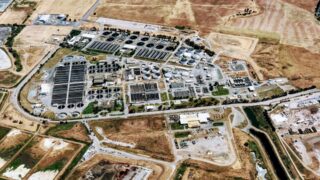AI for Sustainability: Harnessing Technology for a Greener Future
As we strive to protect our planet and create a better future for generations to come, harnessing the power of technology has become essential.
One technology that holds tremendous potential in driving sustainability efforts is Artificial Intelligence (AI). By leveraging AI, we can unlock innovative solutions to address environmental and social challenges.
In this post, we will explore the intersection of artificial intelligence and sustainability, focusing on various sectors where AI can make a significant impact. We will also delve into our expertise with the Transcend Design Generator, a powerful generative design tool that empowers asset owners and designers in their capital planning and conceptual design processes, accelerating capital projects and reducing project risk.
Understanding AI
Before we delve into the potential applications of AI for sustainability, let’s first understand what AI is and its capabilities.
Artificial intelligence refers to the development of computer systems that can perform tasks that typically require human intelligence. These systems can learn from experience, adapt to new information, and execute complex tasks with remarkable speed and accuracy. AI encompasses a range of technologies, including machine learning, natural language processing, computer vision, and robotics.
The Intersection of AI and Sustainability
The integration of AI and sustainability holds tremendous promise for addressing pressing environmental and social challenges. By leveraging AI data centers and technologies, we can optimize resource utilization, enhance decision-making processes, and drive innovation in various sectors. Let’s explore some key areas where AI can contribute to sustainability efforts and reduce carbon fooprint.
AI in Energy Management
AI for Smart Grids
The modernization of power grids is crucial for achieving energy efficiency. AI plays a pivotal role in optimizing smart grids, which integrate renewable energy sources, storage systems, and demand-response mechanisms. With the Transcend Design Generator, asset owners and utilities can evaluate a wider range of options in their capital planning and conceptual design processes, enabling the accelerated development of sustainable energy infrastructure.
Several studies have highlighted the effectiveness of AI technologies in this domain. For example, a study published in Energy Reports journal showed that an AI-based optimization model for smart grids that dynamically adjusted energy generation and distribution can provide utilities with affordable energy securely.
Along with AI tools, Transcend Design Generator (TDG) facilitates energy management for substations by combining the power of generative design with a user-friendly interface. TDG automates the process of generating and analyzing preliminary substation facility designs based on input parameters. It utilizes industry standards, best practices, and decision algorithms to select and size equipment, arrange substation components, and create engineering documents.
Predictive Analytics for Energy Demand
Accurate prediction of energy demand is vital for efficient energy management. AI-powered predictive analytics models can analyze historical data, weather patterns, and other relevant factors to forecast energy demand. By accurately anticipating demand fluctuations, utilities can optimize energy generation, reduce reliance on fossil fuels, and increase the integration of renewable energy sources.
AI in Agriculture and Food Systems
Agriculture and food systems face significant challenges in ensuring sustainable practices and addressing food security concerns. AI can offer valuable insights and solutions to enhance agricultural productivity and reduce environmental impact.
Precision Agriculture and Crop Optimization
Precision agriculture leverages AI technologies such as remote sensing, satellite imagery, and data analytics to enable site-specific farming practices. By precisely monitoring soil conditions, crop health, and resource utilization, farmers can optimize inputs, reduce water and fertilizer usage, and minimize the environmental costs of agriculture.
AI-driven Supply Chain Management
Efficient supply chain management is crucial for reducing food waste and ensuring food security. AI-powered systems can analyze vast amounts of data to optimize logistics, inventory management, and distribution networks. When asset owners and engineers minimize inefficiencies and improve traceability, AI-driven supply chain management can contribute to a more sustainable and resilient food system.
AI in Waste Management
Proper waste management is essential for minimizing environmental pollution and promoting a circular economy. AI technologies offer innovative solutions for optimizing waste sorting and recycling processes.
Smart Waste Sorting Systems
AI-powered smart waste sorting systems utilize computer vision and machine learning algorithms to automate waste segregation. These systems can identify and sort different types of waste materials, enabling efficient recycling and reducing the volume of waste sent to landfills.
AI for Circular Economy
The concept of a circular economy aims to eliminate waste by reusing, recycling, and regenerating materials. AI can play a crucial role in enabling a circular economy by optimizing material recovery, identifying new recycling opportunities, and facilitating the development of sustainable product designs.
The Transcend Design Generator (TDG) is a generative design tool that revolutionizes wastewater treatment facility design and analysis. With its user-friendly interface, TDG allows users of varying expertise to generate and analyze preliminary designs by automating engineering decisions based on simple input parameters. It also incorporates process design simulation, equipment selection, abstract building modeling, and building information modeling (BIM) to create accurate and efficient designs. By leveraging its generative design capabilities, TDG streamlines the design process, ensuring accuracy, consistency, and cost efficiency while meeting sustainability metrics in wastewater treatment facility projects.
AI for Climate Change Prediction and Adaptation
Climate change poses significant challenges that require proactive strategies for both mitigation and adaptation. Sustainable AI can analyze vast amounts of climate data, enabling us to develop effective strategies to tackle climate change while enhancing economic growth.
Climate Modeling and Prediction
AI-powered climate models can simulate complex climate systems and generate accurate predictions. By analyzing historical climate data and incorporating real-time information, these models can help policymakers and researchers understand the impacts of climate change and develop effective mitigation strategies.
AI-enabled Disaster Management
As the frequency and intensity of natural disasters increase, AI can assist in disaster management efforts. Machine learning algorithms can analyze data from various sources, including satellite imagery and social media, to identify patterns and predict potential disaster events. By providing early warnings and supporting emergency response planning, AI can save lives and minimize the impacts of natural disasters.
For instance, in Georgia, the United Nations Development Programme (UNDP) is using AI to develop a nationwide multi-hazard early warning system (MHEWS). By combining on-site observations with historical data from NOAA and ECMWF, an AI tool predicts the probability of severe convective events like hail- and windstorms. This AI-driven approach overcomes the challenge of limited on-site observation networks and complex topography, improving the accuracy of forecasts and hazard maps.
AI in Transportation and Mobility
Transportation systems contribute significantly to greenhouse gas emissions and pollution. AI-powered solutions can transform transportation and mobility by optimizing efficiency, reducing emissions, and enhancing safety.
Intelligent Traffic Management
Artificial intelligence can revolutionize traffic management by analyzing real-time traffic data and optimizing signal timings. Intelligent systems can dynamically adjust traffic flows, reduce congestion, and minimize fuel consumption. By promoting smoother traffic patterns, AI-driven traffic management contributes to reduced emissions and improved air quality.
Autonomous and Electric Vehicles
AI plays a vital role in the development of autonomous and electric vehicles. Machine learning algorithms enable self-driving vehicles to perceive their surroundings, make intelligent decisions, and navigate safely. Additionally, artificial intelligence can optimize electric vehicle charging infrastructure, predicting demand patterns and ensuring efficient use of renewable energy sources.
AI in Water Resource Management
Water scarcity and inefficient water management pose significant challenges worldwide. AI tools can help monitor, conserve, and optimize water resources for environmental sustainability.
Water Quality Monitoring
AI-powered systems can analyze water quality data in real time, detecting contaminants and ensuring safe water supplies. By monitoring various parameters, such as pH levels and pollutant concentrations, AI enables early detection of water quality issues, allowing for timely interventions.
AI for Efficient Irrigation Systems
Optimizing irrigation practices is crucial for sustainable water resource management in agriculture. AI can analyze data from soil moisture sensors, weather forecasts, and plant characteristics to determine precise irrigation requirements. By reducing water waste and improving crop yields, AI-driven irrigation systems contribute to sustainable water usage.
One example of AI in water resource management is the use of Long Short-Term Memory (LSTM) and Convolutional Neural Networks (CNN) to simulate water quality and water levels in a river basin. In South Korea’s Nakdong River basin, LSTM and CNN were employed to predict water quality parameters such as organic carbon, phosphorous, nitrogen contents, and water levels. The models achieved good performance, with the CNN producing an acceptable NSE value and the LSTM performing in the “very good” range. This application of AI helps in understanding and managing water quality and levels, aiding in effective water resource management.
AI in Wildlife Conservation
Preserving biodiversity and protecting endangered species is essential for maintaining a healthy ecosystem. AI can aid wildlife conservation efforts by monitoring and tracking animal populations.
AI-based Animal Tracking and Monitoring
The use of artificial intelligence (AI) in wildlife conservation has revolutionized our approach to protecting and preserving endangered species. AI enables us to analyze data and gain insights into animal behavior, habitats, and potential threats. For instance, researchers have utilized AI to track and monitor deer populations, assisting conservation efforts by providing valuable information on their care and protection. AI can also contribute to understanding the impact of climate change on wildlife by monitoring behavior and habitat. A notable example is the work of Washington State University wildlife biologist Daniel Thornton, who used AI-powered camera traps to measure Canada lynx populations, aiding conservation efforts. Although AI still faces challenges in identifying species in remote and diverse areas, its potential in advancing our understanding of the environment and wildlife conservation is immense.
Wildlife Poaching Prevention
Illegal wildlife poaching poses a severe threat to endangered species. AI can help prevent poaching by analyzing data from acoustic sensors and drones, detecting suspicious activities, and alerting authorities. By enhancing monitoring and surveillance capabilities, AI contributes to the protection of wildlife and the preservation of biodiversity.
Ethical Considerations in AI for Sustainability
While AI offers immense potential for sustainability, it is crucial to address ethical considerations to ensure responsible deployment and mitigate unintended consequences.
Transparency and Explainability in AI
AI systems should be transparent and explainable, enabling users to understand how decisions are made. When we promote transparency, we can build trust and ensure that AI algorithms align with ethical and sustainable principles.
Equity and Accessibility in AI Solutions
To maximize the benefits of AI for sustainability, it is essential to ensure equitable access to AI technologies and solutions. By addressing issues of bias, discrimination, and accessibility, we can create a more inclusive and fair society.
Overcoming Challenges in AI for Sustainability
While AI holds great potential, several challenges must be overcome for its successful integration into sustainability efforts.
Data Availability and Quality
AI models rely on vast amounts of high-quality data for validating and training AI models. Access to comprehensive and reliable data storage and sets can be a significant hurdle. Collaboration between stakeholders, data-sharing initiatives, and the development of data standards are crucial for addressing this challenge.
Regulatory Frameworks
Developing appropriate regulations and governance frameworks for AI is essential to ensure its responsible and ethical use. Policies should address privacy concerns, algorithmic accountability, and potential risks associated with AI deployment in sustainability-related domains.
The Future of AI for Sustainability
As AI technologies continue to evolve, exciting possibilities emerge for driving sustainability efforts.
AI and Green Building Design
AI can revolutionize green building design by analyzing energy consumption patterns, occupancy data, and environmental factors. By generating optimized building designs and suggesting energy-efficient solutions, AI enables the construction of sustainable infrastructure.
AI-powered Climate Change Mitigation Technologies
The development of AI-driven technologies for carbon capture, renewable energy generation, and sustainable manufacturing holds great promise. AI can facilitate breakthrough innovations that address climate change challenges and pave the way for a greener future.
Final Thoughts
AI presents immense opportunities for achieving sustainability goals across various sectors. From energy management and agriculture to waste management and wildlife conservation, AI technologies can optimize resource utilization, enhance decision-making processes, and drive innovation.
With our expertise in the Transcend Design Generator, we empower asset owners and utilities to evaluate more options in their capital planning and design processes, accelerating sustainable development projects and reducing project risk. By harnessing the power of AI and Transcend Design Generator, we can create a greener and more sustainable future for all.







